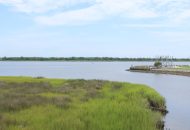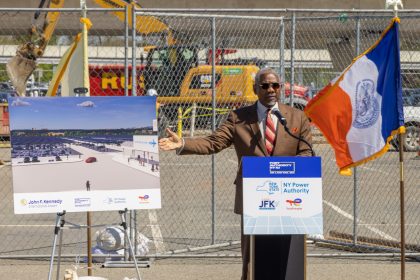Can Trump Win Without Winning the Most Votes? Yes. Pennsylvania Shows How

PHILADELPHIA — Few people think President Donald Trump will win the most votes in the 2020 election. But he could still become the first president to serve two terms without ever winning a majority of the country’s support.
And Pennsylvania is a big reason why.
It’s older and whiter than the country as a whole, and has a larger concentration of white voters who didn’t attend college — playing to Trump’s strength. So while presumptive Democratic nominee Joe Biden has a significant lead nationally and in Pennsylvania, if the overall race tightens, that gives Trump a shot to again win Pennsylvania and the Electoral College, even if he loses the popular vote. In fact, some experts say Trump could lose by even more than he did in 2016, and still secure four more years in the White House.
“If we’re talking about a very close race of the type that we had in 2016, then Trump could conceivably win reelection while losing the popular vote by 5 million or more,” said Dave Wasserman, an elections analyst at the nonpartisan Cook Political Report. “That’s a product of Democrats continuing to gain worthless votes in California, narrowing the margin in Texas and failing to reap any Electoral College benefit from that, while their appeal has stagnated in the Upper Midwest, where the Electoral College is won or lost.”
That’s what happened in 2016, when Hillary Clinton won nationally by almost 3 million votes, but Trump won Pennsylvania, Michigan and Wisconsin by less than 1 percentage point each, or about 107,000 total votes.
It was the third time in the past seven elections the GOP won the White House, despite winning the popular vote just once in that period (in 2004). That’s possible because the Electoral College gives more weight to small, rural states, while Democrats pile up more and more votes in deep blue states like New Jersey and New York.
Pennsylvania has “two urban cores, but it’s got a very large rural population, a big white working class population — all the things that are still net positives for Donald Trump,” said Chris Borick, a pollster at Muhlenberg College in Allentown.
That’s why an average of national polls show Biden leading by about 8.5 percentage points, but only 6.5 in Pennsylvania, according to the website FiveThirtyEight.
“There’s an under-appreciated part of Pennsylvania … which is quite conservative, more rural than a lot of Americans think, and has that white, working-class sensibility,” said Theodore Johnson, who studies race and politics at New York University’s Brennan Center for Justice. “That was a favorable audience for Trump. … It was that sort of Rust Belt, Appalachia message that carried Trump to the presidency.”
A Pew Research Center poll released last week found Biden leading Trump by 8 percentage points nationally, but there were stark divides on education and race. Among whites without college degrees, Trump led 64% to 34%. Among everyone else? Biden 68%, Trump 30%.
Pennsylvania’s electorate, like those of Michigan and Wisconsin, has a larger than average share of non-college whites.
If voter turnout rates stay the same across demographics, about 48% of Pennsylvania voters this year would be white people without college degrees, Wasserman estimates. That’s compared to about 41% nationally.
And while about 28% of the national vote would come from nonwhite voters, in Pennsylvania that share would only be about 18%, largely because the state has a far smaller share of Latino and Asian American residents than the country overall. (The Black vote in Pennsylvania would be close to the national average.)
Of course, some groups could come out more or less than they did in 2016, which would alter the political math. Democrats are hoping Sen. Kamala Harris’ addition to the Biden ticket will help run up the score with both people of color and suburban women.
Even if turnout rates stay the same, Wasserman projects that non-college whites will be a slightly smaller share of the Pennsylvania pie this election, based on population growth in suburban areas and declines in more rural and post-industrial regions. “Pennsylvania, and every other state, is more college educated in 2020 than it was in 2016,” he said, “so (Trump has) got to bring out even more of those non-college whites to offset that.”
But rural areas may also offer more votes for Trump than last time. Out of 5.5 million non-college whites eligible to vote in Pennsylvania in 2016, 2.3 million didn’t, Wasserman said.
“If there’s an opportunity for Biden to gain votes in Pennsylvania, it’s in the suburbs of Chester, Delaware, Montgomery, Allegheny — Pennsylvania’s Whole Foods suburbs, as well as Harrisburg and Lancaster, which are becoming more suburban,” Wasserman said. “But if there’s an opportunity for Trump to offset that, it’s in Erie, it’s in Luzerne, it’s in Westmoreland and Fayette, and all the places where Democrats still hold registration advantages but where Trump broke through in 2016.”
Trump’s recent events have played to his rural and small-city base, and to white voters.
His campaign staged events this week in Erie County and a pro-gun event in the Lehigh Valley, and the president is expected to visit Scranton on Thursday. Promoting racist tropes, Trump also tweeted last week that the “suburban housewife” will support him because he ended policies that he falsely said allowed low-income housing “to invade their neighborhood.”
Pennsylvania’s voting divides are a microcosm of the geographic splits that have come to define American politics.
Nationally, Biden leads Trump by 38 percentage points in urban areas and by 10 in the suburbs, Pew found, while Trump held a 21-point advantage in rural areas. The poll also found Trump performing best with voters over 65 — another demographic over-represented in Pennsylvania — while Biden led overwhelmingly with younger voters.
The geographic divides fit with recent election results and voter registration figures showing increasing GOP strength in Northeast, Central and Southwest Pennsylvania, while Democrats gain in Philadelphia, Pittsburgh, and the suburbs around those cities and Harrisburg.
“That’s not unique to Pennsylvania, but it happens to all add up in Pennsylvania, these trends going in both directions,” said David Hopkins, a political scientist at Boston College University and author of Red Fighting Blue: How Geography and Electoral Rules Polarize American Politics.
Kerry Jobe, the former Republican chairman in Westmoreland County, predicted an even greater Trump margin in that largely rural part of Southwestern Pennsylvania.
“That same wave that happened in ‘16 is happening again and the Democrats don’t want to see it,” Jobe said.
Democrats have tried to erode Trump’s support with the white working class, arguing that he has failed the people he promised to help and hoping Biden will be more acceptable to those voters than Clinton, who inspired unusual levels of antipathy.
“All (Biden) has to do is be acceptable and not anger those disengaged voters to the point that gets them off the couch,” Johnson said.
Pennsylvania’s demographics have shifted slightly in Democrats’ direction, as the state becomes more college educated and slightly more racially diverse.
It’s “still an older, whiter, more working class state, but it is just a tad less so than it was years ago,” Borick said. And if the Democratic coalition comes out strongly, he said, it’s “pretty much a mathematical disaster for Republicans.”
Population growth in Southeast Pennsylvania should benefit Biden, especially as suburban voters increasingly vote Democratic.
“We are the engine that flips Pennsylvania this time,” said Rep. Mary Gay Scanlon, who won a Delaware County-based congressional seat in 2018 as part of the Democratic surge powered by women. “And we’ve got a lot of work to do.”
———
©2020 The Philadelphia Inquirer
Distributed by Tribune Content Agency, LLC.
























